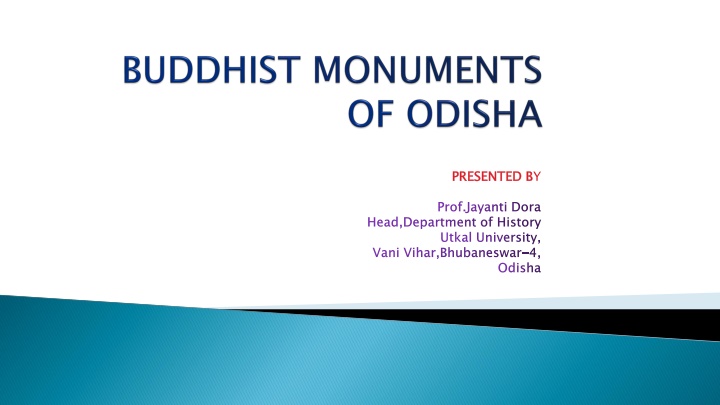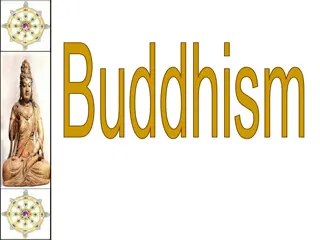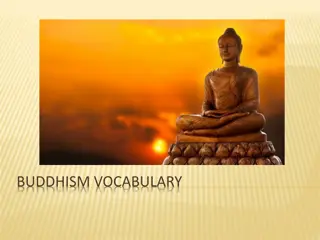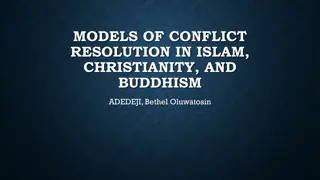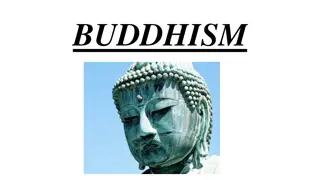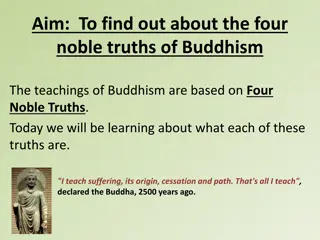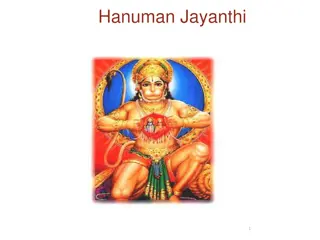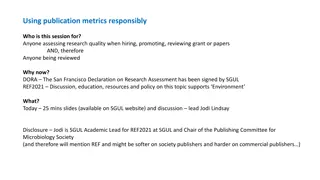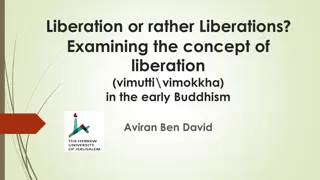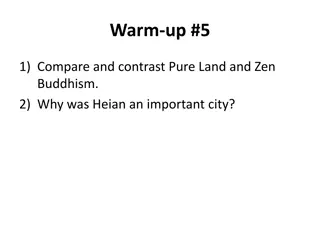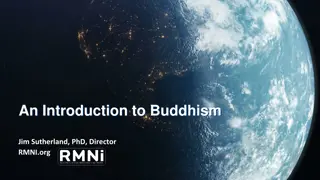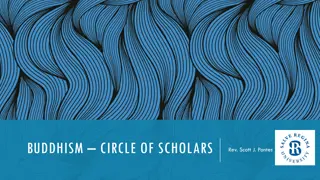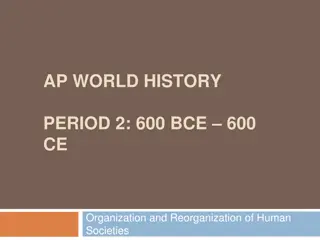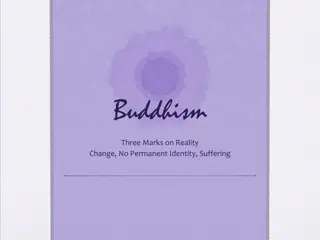Prof. Jayanti Dora's Insight on Buddhism - A Historical Perspective
Explore the profound impact of Buddhism as a religious and moral movement in ancient times through the teachings and enlightenment of Gautama Buddha. Discover the essence of the Four Noble Truths, the significance of reincarnation, and the architectural structures associated with Buddhist practices.
Download Presentation

Please find below an Image/Link to download the presentation.
The content on the website is provided AS IS for your information and personal use only. It may not be sold, licensed, or shared on other websites without obtaining consent from the author.If you encounter any issues during the download, it is possible that the publisher has removed the file from their server.
You are allowed to download the files provided on this website for personal or commercial use, subject to the condition that they are used lawfully. All files are the property of their respective owners.
The content on the website is provided AS IS for your information and personal use only. It may not be sold, licensed, or shared on other websites without obtaining consent from the author.
E N D
Presentation Transcript
PRESENTED B PRESENTED BY Prof.Jayanti Dora of History Utkal Vihar,Bhubaneswar- -4, Prof.Jayanti Dora Head,Department Head,Department of History Utkal University, Vani University, Vani Vihar,Bhubaneswar 4, Odisha Odisha
Buddhism one of the most important religiou movements of ancient world had profoundly influnced the religious and moral ideas and acted as a catalystic factor in transforming the socio-religious order. Buddha lived in the 6th century B.C. It was an age of great upsurge, intellectual and social, in many parts of the world. In India too we notice the upheaval in the domain of political and social ideals, educational system and the like Gautama Buddha was born in a famous Sakya clan in 563 B.C -483 BCE at Lumbini FOUR NOBLE TRUTHS FOUR NOBLE TRUTHS 1. 2. 3. Life is suffering. (Dukkha We suffer because we want or crave or desire. (Dukka Sumudaya We can end dukkha by eliminating our wanting or craving. (DukkaNirodha The way we eliminate wanting is The Eightfold Path (Magga Dukkha) Sumudaya) Nirodha) 4. Magga) The Four Noble Truths came to Gautama after an experience of enlightenment bank of river Niranjana. enlightenment following hours of meditation meditation under a Bodhi Tree on the
Not polytheistic polytheistic or monotheistic monotheistic Some consider it a Dharma a duty in life but not a religion Buddha Buddha means "The Awakened One" The sacred texts are called Sutras Sutras Spread throughout east Asia (India, China, Japan, Korea)
Reincarnation called Samsara No Caste System Souls can be reborn in forms other than human. Karma which determines their fate in the next life. Nirvana through meditation and correct living following noble path. Samsara Karma -- -- the good and bad a person does in this life, Nirvana is a stage of total enlightenment attained
Three types of structures are associated with the religious architecture of Buddhism: Monasteries (Viharas), places to venerate relics (Stupas) shrines or prayer halls (Chaityas, also called Chaitya grihas), which later came to be called temples in some places.
It is Buddhist commemorative monument usually housing sacred relics associated with the Buddha or other saintly persons. The hemispherical form of the stupa appears to have derived from pre-Buddhist burial mounds in India. As most characteristically seen at Sanchi in the Great Stupa (2nd 1st century BC), the monument consists of a circular base supporting a massive solid dome (the anda, egg, or garbha, womb ) from which projects an umbrella.Stupas are four types-Saririka, Paribhogika,Uddesika and Votive. gateways, which are richly decorated with relief sculpture depicting Jataka tales, events in the life of the Buddha, and popular mythological figures. Saririka, Paribhogika,Uddesika and Votive. The whole of the Great Stupa is encircled by a railing and four
The 'Great Stupa' at Sanchi is the oldest stone structure in India and was originally commissioned by the emperor Ashoka the Great in the 3rd century BCE Its nucleus was a simple hemispherical brick structure built over the relics of the Buddha. It was crowned by the Chatra, a parasol-like structure symbolizing high rank, which was intended to honour and shelter the relics. It has four profusely carved ornamental gateways and a balustrade encircling the whole structure.
The Great Stupa at Amaravati was a large Buddhist monument built in south-eastern India between the second century B.C. and the third century A.D. It was a centre for religious activity and worship for hundreds of years. The Stupa was part of a complex of religious buildings built and paid for by local people. Overtime, the Stupa was added to and changed many times.
Fifteen kilometres from Gaya is the site where Lord Buddha gained 'knowledge' (bodhi) and in 300 B.C. it was here that Asoka got a 'Bodhi-Manda' constructed. No trace of the original construction has survived. We have only the remains of the stone pillars constructed during the Sunga period like the railing pillars found around other Stupas and they too have sculpture the panels in relief. They illustrate stories from the Buddhist Jatakas.
Vihra generally refers to a Buddhist monastery for Buddhist renunciates, mostly in the Indian subcontinent. The concept is ancient and in early Sanskrit and Pali texts, it meant any arrangement of space or facilities for dwellings . The term evolved into an architectural concept wherein it refers to living quarters for monks with an open shared space or courtyard, particularly in Buddhism. The term is also found in Ajivika, Hindu and Jain monastic literature, usually referring to temporary refuge for wandering monks or nuns during the annual Indian monsoons.
Vihara or vihara hall has a more specific meaning in the architecture of India, especially ancient Indian rock-cut architecture. Here it means a central hall, with small cells connected to it, sometimes with beds carved from the stone. Some have a shrine cell set back at the centre of the back wall, containing a stupa in early examples, or a Buddha statue later. Typical large sites such as the Ajanta Caves, Aurangabad Caves, Karli Caves, and Kanheri Caves contain several viharas. Some included a chaitya or worship hall nearby.The vihara originated as a shelter for monks when it rains.
A chaitya, chaitya hall, chaitya-griha, (Sanskrit:Caitya; Pli: Cetiya) refers to a shrine, sanctuary, temple or prayer hall in Indian religions. The term is most common in Buddhism, where it refers to a space with a stupa and a rounded apse at the end opposite the entrance, and a high roof with a rounded profile. Strictly speaking, the chaitya is the stupa itself,and the Indian buildings are chaitya halls, but this distinction is often not observed. Outside India, the term is used by Buddhists for local styles of small stupa-like monuments in Nepal, Cambodia, Indonesia and elsewhere. In Thailand a stupa, not a stupa hall, is called a chedi. In the historical texts of Jainism and Hinduism, including those relating to architecture, chaitya refers to a temple, sanctuary or any sacred monument.
Most early examples of chaitya that survive are Indian rock-cut architecture. Scholars agree that the standard form follows a tradition of free-standing halls made of wood and other plant materials, none of which has survived. The curving ribbed ceilings imitate timber construction. In the earlier examples, timber was used decoratively, with wooden ribs added to stone roofs. At the Bhaja Caves and the "Great Chaitya" of the Karla Caves, the original timber ribs survive; elsewhere marks on the ceiling show where they once were. Later, these ribs were rock-cut. Often, elements in wood, such as screens, porches, and balconies, were added to stone structures. The surviving examples are similar in their broad layout, though the design evolved over the centuries.
The evidences from archaeological excavations that took place in Odisha recently,proves that after Asoka till 11centuryA.D. numerous Stupas,Viharas and centers of learning of Buddhism sprang up in different parts of Odisha. Even though Lord Buddha had never visited Odisha during his lifetime, the state has a rich heritage of Buddhism. In fact, Odisha is home to more than 200 Buddhist sites, scattered across its length and breadth. Here, Buddhism flourished from the 6th century BC to at least 15th to 16th century AD. After the death of the Buddha, his followers were divided into two sects 'Hinayana' and 'Mahayana'. The latest Buddhist phase is 'Vajrayana' which is believed to have been originated from Odisha. According to the Buddhist scholars of Odisha Institute of Maritime and South East Asian Studies, Biraja (modern Jajpur) was a sacred land of Buddha Padmaprabha and the cradle of 'Mahayana'. The presence of 'Mahayana' antiquities, stupas and relics in Jajpur district are a testimony to this.
In the early medieval period of Indian history some of the Buddhist sites rose to prominence as center of excellence so far Buddhist learning is concerned. Here, number of monasteries were built to accommodate the disciples and Buddhist teachers. Nalanda and Vikramsila even rose to prominence as universities. In Odisha, references are found that a Buddhist learning center Puspagiri rose to prominence in 6 th century A.D., which was mentioned by Chinese traveller Yuan Chwang. References are found in various Buddhist literature that monasteries like Bhojakgiri Vihara, Puspagiri Mahavihara, Bhorasaila, and Jagdala Monasteries were flourished as centers of Buddhism. Jayasrama Vihara,Arghyika Varatika, The Buddhist art centers have been developed during historical period at Dhauli, Lalitagiri, Ratnagiri,Udyagiri,Vajragiri, Langudi, Kayma, Tarapur, Kuruma, Jajpur, Achutrajpur,Ayodhaya,Kupari,Solampur,Ganiapali, Boudh, Khiching, Aragada etc.The art antiquity comprises huge Stupas Monastries, Chaityas, Buddha and Bodhisattava images, Mahayana pantheons, Vajarayana images and host of other sculptures.
The history of Buddhist Monuments date back to Kalinga War i.e 261 B.C. Flourished under the direct patronization of Mouryan Emperor Ashoka to propagate Buddhism in his newly acquired province of Kalinga. Buddhist art of Bhubaneswar
Specimen of Buddhist Monuments Includes. Remains of an Ashokan Pillars in form of Siva Linga in Bhaskareswar temple. The Capital of Ashokan Pillar in the premises of Orissa State Museum. The Forepart of an elephants andAshokan Edicts at Dhauli. The Remains of a Lion as Crowning element of Ashokan pillar now preserved at Orissa State Museum. Some fragments of railings of Stupas, Monasteries, Images of Lord Buddha etc are found in different places of Odisha.
Dhauli or Dhauligiri is a hill located on the banks of the river Daya, 8 km south of Bhubaneswar in Odisha. It's known for "Dhauli Santi Stupa", a peace pagoda monument which witnesses the great Kalinga War built by Japan Budhha Sangha and Kalinga Nippon Budhha Sangha.Shanti Stupa (Peace Pagoda) at Dhauligiri in 1973 AD. The Dhauli Major Rock Inscription of Ashoka. The front is shaped as an elephant. Dhauli, Puri District, India.
Ratnagiri meaning "hill of jewels" is the site of a ruined mahavihara, once the major Buddhist monastery in modern Odisha, India. It is located on a hill in between the Brahmani and Birupa rivers in Jajpur district. It is close to other Buddhist sites in the area, including Lalitagiri and Udayagiri, famous as diamond triangle. The Buddhist monuments were constructed from the 5th century CE onwards, with the last work in the 13th century, and the peak period of work done between about the 7th to 10th centuries. After perhaps in the 16th century the site ceased to be used and fell into ruins. The main elements were an impressive stupa (Stupa 1) surrounded by several hundred smaller stupas of varying dimensions, three quadrangular monasteries (Monasteries 1 to 3). Monastery 1 is much the largest, with a beautiful carved doorway, spacious open courtyard, cells and verandah facing the courtyard, with a spacious shrine centred on a colossal Buddha.
The buildings are mainly in brick (much of which has now been removed), but the doorways, pillars and sculpture are mostly in two types of stone, which contrast attractively. These are a "blue-green chlorite and the local khondalite, a garniferous gneiss with plum-coloured overtones". The large numbers of sculptures in stone, with a few (27) bronze and brass figures, excavated at the site are mostly in the "Post-Gupta" style, the earlier ones continuing the classic style of Gupta art. They are mostly images of Buddha and the Buddhist pantheon, and analysis of the trends in subjects over time suggests that Ratnagiri turned to become a centre of Tantric Buddhism, as did Nalanda in Bihar. In particular, over two dozen colossal Buddha heads have been found.
Monastery 1 21 square metres for the paved central courtyard. It had at least two storeys, but everything above the ground floor has now collapsed. There are 24 surviving cells on the ground floor, relatively large and probably occupied by more than one monk. One was used as the monastery treasury. They are windowless, and were fitted with wooden doors, and probably locks. Monastery 1 is much largest of the three monasteries, with an overall size of 55 square metres, including Across the courtyard from the entrance, which has two layers of porch, is the main shrine, whose elaborately sculpted facade is now isolated in the courtyard. The main shrine image is a colossal seated Buddha, 12 feet (3.7 m) high including the base, flanked by smaller standing figures of Padmapani and Vajrapani holding chamaras. These are in chlorite, with the Buddha carved in a number of horizontal sections. Monastery 1 was built in at least two major phases, the first dating to the late 8th century, and the second to the 11th or early 12th century;Donaldson prefers the early 10th century for the second phase. The style of sculpture differs considerably between these, and scholars have generally seen the later work as representing a decline in "both moral and artistic standards", as the later work includes some erotic scenes.
Door jam the main outside wall, which was faced with stone at a later stage than the original construction. The frame was called by Mitra "the loveliest entrance to a structural monastery in the whole of India". Door jam-The main entrance to the monastery is through an elaborately carved chlorite doorway set back from It has three main zones, the innermost "an intricate foliated arabesque pattern" with a thin vine stem undulating up it. Next comes a zone with stylized lotus petals, usually seen on curved surfaces, and "quite unique" as a flattened pattern. The outer side elements switch from green chlorite to red stone in mid-composition in the large plant scroll inhabited by playing putti (gelabai), with some bodies half in one stone and half in the other. Across the top lintel there was a relief of vidyadhara figures, of which only the feet remain. In the centre an inset guardian figure of Gaja-Laksmi, borrowed from the Hindu pantheon, runs through two zones. At the bottom of the sides there are two panels each with four richly but lightly dressed lay figures, one holding an umbrella. These are "door guardians" and the innermost figures are large males leaning on clubs; however, the overall impression of the groups is hardly intimidating.
Around the entrance were a number of large relief panels of standing figures, several now removed elsewhere. On the outside wall the only one left in place is the female figure (illustrated) holding a flowering branch and making the varadamudra with her proper right hand. She is perhaps a river goddess, or Marici. In a niche inside the porch is an image of the river goddess Yamuna in "sisterly cameraderie" with two smaller companions (illustrated below). There was probably a matching Ganga panel on the other side, but this is now missing; the pair are very common figures at the threshold of Buddhist and Hindu establishments.
Other common figures in monasteries are pairs of Pancika (the Hindu Kubera) and his consort Hariti, representing material and spiritual wealth at more than one level.[20] The style of these figures demonstrates that they were made at the same period as the sculpture on the Baitala Deula Hindu temple in Bhubaneswar, and it has been suggested that some individual sculptors worked at both sites, "a lack of sectarian specialization" in builders and carvers in India being very common. The monastery courtyard had a large verandah, now mostly vanished, probably giving an effect and utility similar to the cloisters of European Christian monasteries. One part, with a central doorway flanked on both sides by three niches, was exceptionally elaborate, and has been reconstructed by the ASI, replacing missing elements with matching shaped but undecorated stone blocks. This was a later addition, called by Reichle the "third facade to rear shrine". The carving includes numerous small figures, often now hard to identify. This now stands alone in the courtyard, not quite in its original position.
Monastery 2 central paved courtyard flanked by a pillared veranda around which are eighteen cells in Varada Mudra flanked by Brahma and Sakra, and elaborately ornamented entrance porticos. It only had a single story. Monastery 2- -, next to Monastery 1 but much smaller, features a eighteen cells, a central shrine featuring an image of Shakyamuni It may have been the first to be built, as Mitra dates the first construction to about the 5th century (as opposed to the 8th for Monastery 1), with more building in the 7th and 11th centuries. Monastery 3 smaller again, with only three cells Monastery 3- - is on a small hillock to the north-west, and much three cells in a row, and a portico.
The main stupa dates to the 9th century and was likely built on the site of an earlier, Gupta-era stupa. It is on the highest point in the site and has a square base, 47 feet (14 m) metres on each side. The stupa is now 17 feet (5.2 m) high, but was originally a good deal higher, to an unknown extent. There was a pathway between the plinth and outer wall for ritual pradakshina or circumambulation; this was a later addition.Prominent, well-preserved standing statues of the bodhisattvas Vajrapani and Padmapani can be found in niches in a portico. The stupa is surrounded by large numbers of much smaller stupas, some four or more metres high, but large numbers less than a metre. Most of the smaller ones show a seated deity figure in a niche on one side, and many are decorated with lotus petals and beaded tassels around their shaft.These are mostly carved from a single piece of stone. Many Indian Buddhist sites have some of these, but at Ratnagiri there are more than 700 of them in total, which is an exceptionally large number, and they represent an exceptional range of deities, with 22 identified. Some 535 of the total are found to the south-west to the main stupa.
Most can be dated to between the 9th and 13th centuries, and were evidently made on or very close to the site; some unfinished examples have been found, including those with the space for the figure left blank, to be finished when the customer chose a deity. It is thought they served as memorials and reliquaries for dead monks, and votive offerings by pilgrims. A total of 1386 clay seals were found, most bearing the legend Sri Ratnagiri Mahavihariya Aryabikshu Sanghasya, which helped to identify the name of Ratnagiri monastery. One temple has been converted to Hindu use as the Dharma Mahakala temple; this was built over an earlier stupa, and was moved to the side of the site and re-erected by the ASI. It contains a Buddhist standing relief figure of Manjushri.The later parts date to the 11th century.
Ratnagiri was likely established no later than the reign of the Gupta king Narasimha Baladitya in the first half of the sixth century, and flourished until the twelfth century. The main construction of the surviving part of Monastery 1 was under the rule of the (mainly) Buddhist Bhauma-Kara dynasty, whose capital was nearby at Jajpur, although no inscription records patronage at Ratnagiri by the dynasty. A Tibetan history, the Pag Sam Jon Zang, identifies Ratnagiri as an important centre in the development of the Kalachakratantra in the 10th century, an assertion supported by the discovery of a number of votive stupas, plaques, and other artifacts featuring Kalachakra imagery. It was thought, with Lalitgiri and Udaigiri nearby, to be the Pushpagiri Vihara mentioned by the 7th-century Chinese pilgrim Hiuen Tsang, but this has been thrown into doubt by the discovery in the 1990s of a previously unknown site in the area on Langudi Hill, which may be Pushpagiri. The hundreds of small votive stupas at Ratnagiri suggest it was an important site for pilgrimage, and it was very likely connected to the important trade networks of ancient Kalinga, which stretched to South- East Asia.
North-East India, Bengal and Odisha, was the last stronghold of Buddhism in India, though greatly weakened by the Muslim invasions of the 12th century, which completely destroyed the greatest centre in the region at Nalanda. By the end of the 13th century, Ratnagiri was in decline, and new work ceases. Through no longer in an affluent condition the Buddhist establishment at Ratnagiri is thought to have continued until about the 16th century, during which there was a "modest revival of structural activity", including a restoration of the main stupa. Unlike, for example, the Ajanta Caves, which were completely forgotten for centuries (except by local villagers), the ruins of Ratnagiri were known about, and are briefly discussed in government reports from the late 19th century onwards, with "brief articles by scholars" from the 1920s onwards.
Iconography: The identification and iconography of the figures in sculpture at Ratnagiri have been the subject of considerable analysis, although much remains uncertain. The exceptionally large number and range of figures shown, above all on the small stupas, makes Ratnagiri an outstanding Indian site for the study of Buddhist images.An evolution of the prevailing religious thought has been detected, reflected in the choice of images, and relating them to a wider range of Buddhist texts, despite very little evidence as to what texts or practices were used or even known at Ratnagiri itself. The religious affiliations of the monastery probably changed over its long history, and it seems it was often the case that different Buddhist traditions co-existed within a single monastery. Iconography:- -
The "overwhelming majority" of the sculpture can be grouped into two phases, the first dating to the 8 9th centuries, dominated by imagery described as Mahayana by Donaldson, followed by a second phase of the 10th and 11th centuries, with mainly Vajrayana choice of subjects and imagery. However, some other scholars question these descriptions, seeing evidence of Tantricism in the earlier phase as well. The issue revolves around the choice of deities, and the form, aspect or just the pose and iconography in which they are depicted. The site features statues of Tara, Avalokiteshvara, Manjusri, Aparajita, Hariti and a range of other bodhisattvas. Ratnagiri is notable for a larger proportion of female figures than other groups of Buddhist sculpture, which has been connected with an increasing interest in esoteric forms of Buddhism, though writers disagree over which traditions were involved.
Debala Mitra records that when the main ASI excavation began in 1958, the local people had lost all memory of the site as a religious foundation, and believed the mounds had been the palace of a "mythical king", calling them "the queen's mound" ("Ranipukhuri"). A large-scale excavation was conducted at the site by the ASI between 1958 and 1961, uncovering most of what is known today. The report of these excavations was published by the ASI (Mitra, 1981 and 1983). In this twenty year interval a thesis and article were published.There was a further ASI campaign in 1997 2004, which concentrated on moving the temple which had been built over a stupa. The large amount of sculpture surviving has been analysed in a number of publications.
Sculptures now protected by a grille Apart from the clay seals mentioned above, only three inscriptions of any significance have been found at the site, all extracts from Buddhist texts, in two cases dealing with the rewards accruing to those who erect stupas. One is carved on stone slabs, another written on terracotta plaques before firing, and one engraved on the back of a sculpture. A growing number of images of "wrathful deities", that is, fierce "aspects" of enlightened Buddhas, Bodhisattvas or Devas (divine beings), may be taken as evidence of a turn towards esoteric Buddhism. Examples include Heruka. Two small scenes, now difficult to interpret, seem to show erotic activity combined with the cutting of hair. These are very rare, and may relate to the practice, described in some Hindu Tantric texts but no known Buddhist ones, of offering both semen and cut hair to a deity (Kali especially). They are on the later second and third facades to the main shrine room.
Museums The Ratnagiri museum occupies a purpose-built modern building at the site. It has three storeys and four galleries, with a range of objects found on the site on display. Three galleries mainly feature stone sculpture, and the fourth bronze and ivory sculptures, terracottas, clay seals, inscribed copper plates, and other finds. Other sculptures are "scattered in local villages", and several are in museums, including the Patna Museum, Indian Museum, Kolkata, National Museum, New Delhi, and Odisha State Museum in Bhubaneswar. The only holding outside India mentioned by Donaldson is a figure in the Brooklyn Museum, New York.
